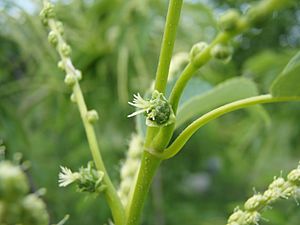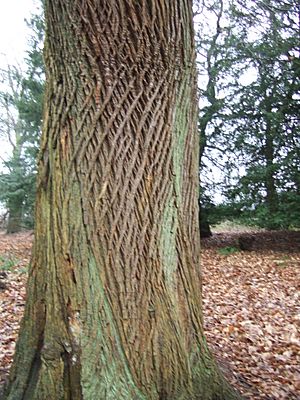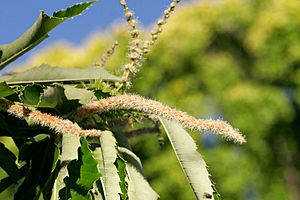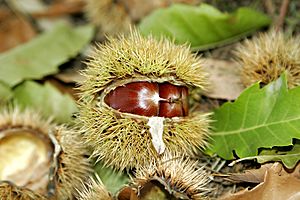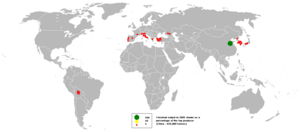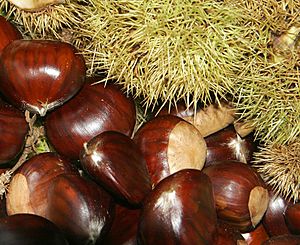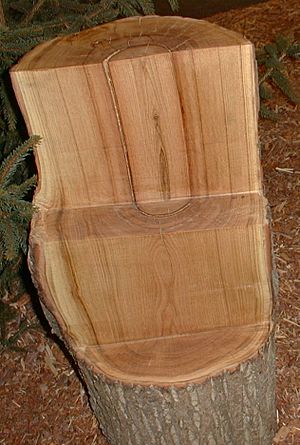Chestnut facts for kids
Quick facts for kids Chestnut |
|
|---|---|
 |
|
| Sweet chestnut Castanea sativa | |
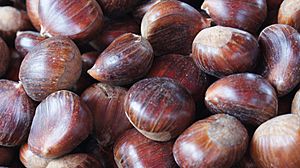 |
|
| The edible nut being sold at a market | |
| Scientific classification |
|
| Kingdom: | Plantae |
| Clade: | Tracheophytes |
| Clade: | Angiosperms |
| Clade: | Eudicots |
| Clade: | Rosids |
| Order: | Fagales |
| Family: | Fagaceae |
| Subfamily: | Quercoideae |
| Genus: | Castanea Mill. |
| Species | |
Chestnuts are a group of eight or nine different kinds of trees and shrubs. They are known for losing their leaves in the fall. These plants belong to the Castanea group, which is part of the beech family. Chestnuts grow naturally in cool, mild areas of the Northern Hemisphere.
The name "chestnut" also refers to the tasty nuts that these trees produce.
Contents
Different Kinds of Chestnuts
Chestnuts are part of the Fagaceae family, which also includes oaks and beech trees. There are four main groups of chestnuts: American, European, Chinese, and Japanese.
| Group | Image | Scientific name | Common Name | Where They Grow |
|---|---|---|---|---|
| American Chestnuts | 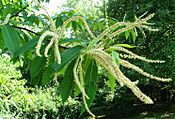 |
Castanea dentata | American chestnut | Eastern United States |
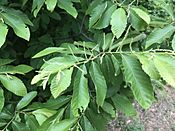 |
Castanea pumila | American or Allegheny chinkapin (also called "dwarf chestnut") | Southern and Eastern United States | |
| Asian Chestnuts | 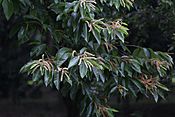 |
Castanea mollissima | Chinese chestnut | China |
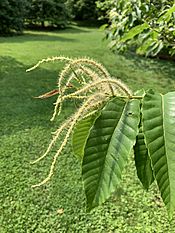 |
Castanea henryi | Chinese chinkapin (also called Henry's chestnut) | China | |
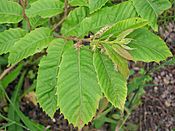 |
Castanea seguinii | Seguin's chestnut | China | |
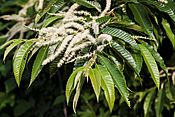 |
Castanea crenata | Japanese chestnut, Korean chestnut | Malaysia and parts of Southeast Asia | |
| European Chestnut | 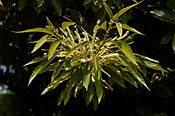 |
Castanea sativa | Sweet chestnut (also called "Spanish chestnut") | China, also found in the Himalayas and other temperate parts of Asia. |
It's important not to confuse true chestnuts with horse chestnuts. Horse chestnuts are not real chestnuts and their nuts are mildly poisonous to humans. Also, water chestnuts are not related; they are tubers from a water plant.
Other trees sometimes mistaken for chestnuts include the chestnut oak and the American beech. Both are also in the Fagaceae family.
What's in a Name?
The word "chestnut" comes from an old English term, "chesten nut." This came from the Old French word chastain, which then came from the Latin word Castanea. The Latin word itself came from the Ancient Greek word kastanon, meaning "sweet chestnut."
One idea is that the Greek word came from an ancient town called Kastanea in Greece. This town might have been named after the many chestnut trees growing there. Another idea is that the name came from "Sardis acorn," referring to a fruit that spread from Sardis, a city in Asia Minor.
How Chestnuts Look and Grow
Chestnut trees grow at different speeds. Chinese chestnut trees grow moderately, while American and European species grow fast. Their height varies a lot. Some chinkapin species are often small shrubs. The American chestnut, which used to be giant, could reach 60 meters (about 200 feet) tall!
Japanese chestnuts are usually about 10 meters (33 feet) tall. Chinese chestnuts are around 15 meters (50 feet), and European chestnuts can reach about 30 meters (100 feet).
Chinese and Japanese chestnuts often have many main branches and spread wide. European and American species tend to grow very straight and tall when planted close together. Their leaves turn a beautiful yellow in the fall.
When young, the bark of a chestnut tree is smooth. American chestnuts have a reddish-brown bark, while European chestnuts have grey bark. As the trees get older, the bark becomes thick and deeply grooved. These grooves run up and down the trunk and sometimes twist.
The leaves are simple, oval-shaped, and have sharp, widely spaced teeth. They are about 10–30 cm (4–12 inches) long and 4–10 cm (1.5–4 inches) wide.
Flowers and Fruit
The flowers appear in late spring or early summer. They grow in long clusters called catkins. Both male and female flowers grow on the same tree. The male flowers appear first and produce pollen. The pollen has a strong, sweet smell.
Other catkins have male flowers but also small groups of female flowers that will produce fruit. These female flowers are covered by a prickly case called a calybium, which later becomes the brown, spiny husk that covers the nuts.
Chestnut trees need at least two different trees to pollinate each other. This means they can't pollinate themselves. All types of Castanea chestnuts can easily mix and create new kinds of trees.
The fruit is inside a very spiny ball called a "burr," which is about 5–11 cm (2–4 inches) wide. These burrs often grow in pairs or clusters on the branch. Each burr can hold one to seven nuts, depending on the type of chestnut.
When the nuts are ready, the burrs turn yellow-brown and split open. They might open while still on the tree or after falling to the ground.
The chestnut nut has a pointed end and a pale brown scar where it was attached. It has two skins: a hard, shiny brown outer skin (the "peel") and a thinner inner skin called the pellicle. This inner skin sticks closely to the nut.
Inside, the nut is creamy-white. Some special types of chestnuts, called "marrons," are large and rounded with an inner skin that is easy to remove.
Chestnut seeds start to grow right after they fall to the ground in the autumn. Their roots come out first, and then the leaves and stem appear the next spring. Because they don't have a protective coating or a long-lasting food supply, they must be planted soon after they ripen.
American chestnuts are usually very small but taste sweet and have easy-to-remove inner skins. Japanese varieties can have very large nuts, but their inner skins are often hard to remove. Chinese chestnuts usually have easy-to-remove inner skins and vary in size.
History of Chestnuts
| Rank | Country | 1979 | 2009 | 2010 | 2011 | 2016 | 2017 | 2018 | 2019 |
|---|---|---|---|---|---|---|---|---|---|
| 1 | 123,000 | 1,550,000 | 1,620,000 | 1,700,000 | 1,879,031 | 1,939,719 | 1,965,351 | 1,849,137 | |
| 2 | 46,000 | 61,697 | 59,171 | 60,270 | 64,750 | 62,904 | 63,580 | 72,655 | |
| 3 | 80,930 | 75,911 | 68,630 | 55,780 | 56,244 | 52,764 | 53,384 | 54,708 | |
| 4 | 70,849 | 50,872 | 48,810 | 57,493 | 50,889 | 52,356 | 53,280 | 39,980 | |
| 5 | 13,160 | 14,000 | 20,900 | 21,500 | 31,557 | 36,000 | 35,230 | 28,980 | |
| 6 | 22,224 | 24,305 | 22,350 | 18,271 | 26,780 | 29,875 | 34,165 | 50,000 | |
| 7 | 65,300 | 21,700 | 23,500 | 19,100 | 16,500 | 18,700 | 16,500 | 15,700 | |
| 8 | 37,515 | 10,000 | 10,000 | 10,000 | 16,185 | 15,623 | 15,091 | 25,500 | |
| 9 | 5,200 | 10,201 | 9,628 | 11,000 | 12,540 | 12,540 | 12,823 | 12,872 | |
| 10 | 53,751 | 8,672 | 9,464 | 7,160 | 8,642 | 8,406 | 8,683 | 7,350 | |
| 11 | - | 5,580 | 5,450 | 5,200 | 6,040 | 6,226 | 5,242 | 5,846 | |
| 12 | - | - | - | - | 2,718 | 2,108 | 2,166 | 2,848 | |
| 13 | - | - | - | - | 1,142 | 1,154 | 1,179 | 2,109 | |
| 14 | - | - | - | - | - | 1,100 | 1,100 | 1,100 | |
| 15 | - | - | - | - | 763 | 634 | 614 | 593 | |
| 16 | - | - | - | - | 502 | 503 | 515 | ||
| 17 | - | - | - | - | 510 | 396 | 407 | 1,439 | |
| 18 | - | - | - | - | 218 | - | 229 | 228 | |
| 19 | - | - | - | - | 76 | 63 | 225 | 60 | |
| 20 | - | - | - | - | 177 | 180 | 180 | 265 | |
| 21 | - | - | - | - | 218 | 227 | 148 | 200 | |
| 22 | - | - | - | - | 33 | 31 | 37 | 40 | |
| 23 | - | - | - | - | - | - | - | 120 | |
| — | World | 528,433 | 1,890,179 | 1,954,623 | 2,022,831 | 2,261,589 | 2,327,495 | 2,353,825 | 2,406,903 |
| Source: UN Food & Agriculture Organization | |||||||||
Chestnuts have been a very important food in southern Europe, Turkey, and parts of Asia for thousands of years. They were especially important in mountain areas where other grains didn't grow well. People have been growing chestnuts since about 2000 BC.
Alexander the Great and the Romans helped spread chestnut trees across Europe. An old Greek army even survived a difficult journey by eating chestnuts. Before potatoes became common, many communities living in forests relied on chestnuts as their main source of food. In some parts of Italy, a cake made from chestnuts was used instead of potatoes.
There are very old chestnut trees, like the Tortworth Chestnut in England, which was a famous landmark hundreds of years ago. The Hundred Horse Chestnut on Mount Etna in Italy is even older and is one of the oldest living chestnut trees.
In 1584, the governor of Genoa ordered farmers in Corsica to plant four trees each year, including a chestnut tree. This led to many chestnut forests and helped communities grow. In France, a special candied chestnut called marron glacé is a traditional Christmas treat. In Portugal, people eat roasted chestnuts on St. Martin's Day.
Over the last few centuries, chestnuts became less popular because they were seen as "food for poor people." People didn't like chestnut bread because it didn't rise like wheat bread. However, their popularity is growing again, partly because of efforts to replant trees that are resistant to diseases.
Today, China is the biggest producer of chestnuts. In Italy, the Mugello region is famous for its sweet chestnuts, which are known for their good taste and easy-to-remove skins. France also produces chestnuts, especially in the Ardèche region.
Chestnuts in Asia
In Japan, chestnuts are always part of the New Year's menu. They represent success and strength. The Japanese chestnut has been grown for a long time, and the Chinese chestnut might have been grown for 2,000 to 6,000 years.
During British rule in India, sweet chestnut trees were brought to the Himalayas. They are now often seen as ornamental trees in gardens and official buildings. China has about 300 different types of chestnut trees.
Chestnuts in North America
American Indians ate American chestnuts long before Europeans arrived. In some areas, like the Appalachian Mountains, chestnuts made up a quarter of all hardwood trees. These trees grew very tall and straight. For 300 years, many barns and homes in the eastern U.S. were built from chestnut wood.
However, in the early 1900s, a disease called chestnut blight nearly wiped out the American chestnut. Within 40 years, almost all four billion American chestnut trees were destroyed. Today, only a few scattered trees remain, or old stumps that still try to grow new shoots.
Scientists are now working to create new American chestnut trees that are resistant to the blight. They are mixing American chestnuts with Asian species that are naturally resistant to the disease. The goal is to bring back this important tree.
Today, the demand for chestnuts in the U.S. is higher than the supply. Most chestnuts are imported from Italy, China, and South Korea. Growing chestnuts in the U.S. is still a small industry, but it is slowly growing.
Chestnuts in Australia and New Zealand
European chestnut trees were first planted in Australia in the 1850s by settlers. Most chestnut farms in Australia still grow European chestnuts. Some trees in northern Victoria are over 120 years old and 60 meters (200 feet) tall.
Australia produces about 1,200 metric tons of chestnuts each year, mostly from northeast Victoria. Chestnuts are becoming more popular in Australia. The Japanese chestnut was brought to New Zealand in the early 1900s and grows well there.
What's Inside a Chestnut?
| Nutritional value per 100 g (3.5 oz) | |
|---|---|
| Energy | 820 kJ (200 kcal) |
|
44 g
|
|
| Sugars | 11 g |
|
1.3 g
|
|
|
Protein
|
1.6 g
|
| Vitamins | Quantity
%DV†
|
| Vitamin A equiv. |
0%
1 μg |
| Thiamine (B1) |
13%
0.144 mg |
| Riboflavin (B2) |
1%
0.016 mg |
| Niacin (B3) |
7%
1.102 mg |
| Vitamin B6 |
27%
0.352 mg |
| Folate (B9) |
15%
58 μg |
| Vitamin B12 |
0%
0 μg |
| Vitamin C |
48%
40.2 mg |
| Minerals | Quantity
%DV†
|
| Calcium |
2%
19 mg |
| Copper |
21%
0.42 mg |
| Iron |
7%
0.94 mg |
| Magnesium |
8%
30 mg |
| Manganese |
16%
0.34 mg |
| Phosphorus |
5%
38 mg |
| Potassium |
16%
484 mg |
| Sodium |
0%
2 mg |
| Zinc |
5%
0.49 mg |
| Other constituents | Quantity |
| Water | 60.21 g |
| †Percentages estimated using US recommendations for adults. | |
Unlike most other nuts, chestnuts have very little protein or fat. Most of their calories come from carbohydrates. Fresh chestnuts have about 800 kJ (190 kcal) of energy per 100 grams, which is much less than walnuts or almonds.
Chestnuts contain no cholesterol and very little fat. They also do not contain gluten.
They have a lot of starch, even more than potatoes. They also contain about 8% sugar. Because of their high carbohydrate content, sweet chestnut trees are sometimes called "bread trees."
Chestnuts are the only "nuts" that contain vitamin C, with about 40 mg per 100 grams. This is about 65% of the daily amount recommended in the U.S. However, the amount of vitamin C goes down by about 40% when cooked.
Fresh chestnuts are about 52% water, so they can dry out quickly if not stored properly.
Growing Chestnuts
Climate and Soil
Chestnuts grow best in cool weather during their resting period. Frost and snow are good for the trees. Young chestnut shoots, however, are sensitive to frost in spring.
Chestnut trees can grow at different heights above sea level, usually between 200 and 1000 meters (650 to 3,300 feet). They can also handle being near the sea, but they won't grow as much.
Seeds sprout in late winter or early spring, but they don't last long. It's best to plant them as soon as they are ripe. Young trees need protection from cold in their first winter, and also from mice and squirrels.
Chestnuts need at least two trees for pollination, as they cannot pollinate themselves.
Chestnuts grow best in soil that drains water well and has enough moisture. They prefer deep, sloped soils and don't like shallow or heavy clay soils. Chinese chestnuts can even grow in dry, rocky, or poor soils.
While chestnuts can grow in very acidic soil, they prefer a pH between 5.5 and 6.0. They don't grow well in alkaline soils (like chalky soil).
Sunlight and Water
Chestnut trees need a lot of sunlight to grow best. Planting trees far apart helps them get more sun, which means more fruit.
Chestnut trees need about 800 mm (31 inches) or more of rain per year, spread evenly. If there's less rain, they need extra watering, especially young trees in summer and early autumn. Once they are established, they can handle dry periods well.
Storing Chestnuts
Besides being eaten fresh, chestnuts can be canned, made into a puree, or preserved in sugar syrup (like marrons glacés). Cooked chestnuts should be kept in the fridge and used within 3–4 days. They can also be frozen for up to 9 months.
Because chestnuts have a lot of water, they act more like fresh fruits than nuts. They should always be kept cool. To keep them fresh for a few months without a fridge, they can be soaked in cold water after harvest, then dried and stored in dry sand.
Pests and Diseases
Chestnut trees can be affected by various pests and diseases.
Animals and Birds
- Grey squirrels can strip bark from trees.
- Rabbits and wallabies can harm young trees, so fences are often used to protect them.
- Cattle and horses might damage fallen chestnuts during harvest.
- Birds like sulphur-crested cockatoos and Rosellas can also cause damage.
- Small animals like shrews, squirrels, and mice often eat chestnut seeds after they sprout.
Insects
- The oriental chestnut gall wasp, Dryocosmus kuriphilus, is a major pest that attacks and destroys chestnut fruit.
- Moth larvae, like the polyfag moth, can damage shoots and leaves.
- The chestnut weevil often damages the nuts. Its larvae eat the nuts from the inside. Farmers try to pick up chestnuts quickly after they fall to reduce these pests.
- Aphids, like the oak aphid, suck on young shoots and leaves, slowing down growth.
Diseases
- Chestnut blight (Cryphonectica parasitica) is a very serious fungus. It destroyed almost all American chestnut trees in the early 1900s. Asian chestnut species are more resistant to it. Scientists are using these resistant species to breed new American chestnuts that can fight off the disease.
- Ink disease attacks the roots and lower trunk of the tree. Leaves turn yellow and fall off, and fruits stay small. It's caused by fungi like Phytophthora cambivora.
- Root rot is caused by the honey fungus. It's more common in heavy, poorly drained soils.
- Leaf spot is a common disease that causes white spots on leaves, which turn brown and can make the tree lose its leaves.
- Oak mildew mostly affects younger trees, slowing their growth and making them sensitive to frost.
Coppicing
Many chestnut trees are grown using a method called coppiceing. This means they are cut down every 10-12 years. This provides smaller wood that doesn't split as easily as large logs. This wood is used for firewood, fences, and poles.
How We Use Chestnuts
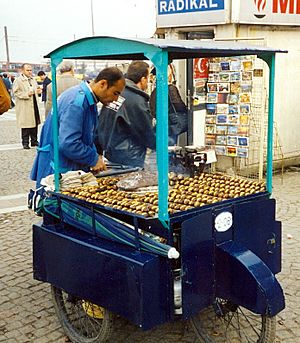
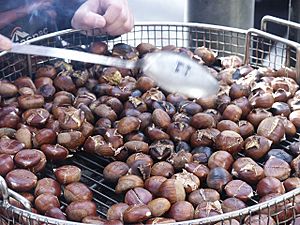
Eating Chestnuts

You can peel and eat chestnuts raw, but they might taste a bit bitter if the inner skin isn't removed.
A popular way to eat them is by roasting. You need to cut a slit in the chestnut before roasting to stop it from exploding. Once cooked, they taste sweet and nutty, similar to a baked potato. Roasted chestnuts are popular in many countries.
Chestnuts can also be dried and ground into flour. This flour can be used to make breads, cakes, pies, pancakes, and pasta. It can also thicken stews and soups. Chestnut bread can stay fresh for up to two weeks.
Chestnuts can be candied, boiled, steamed, fried, or grilled. They are used to stuff vegetables and meats. You can buy them fresh, dried, ground, or canned.
Candied chestnuts, called marrons glacés in French, are whole chestnuts cooked in sugar syrup and then iced. They became popular in France in the 16th century. A civil engineer named Clément Faugier found a way to make them on a large scale in 1882.
In Spain, on October 31st, people celebrate la castanyada by eating chestnuts, sweet potatoes, and other treats. In Portugal, it's traditional to eat roasted chestnuts on St. Martin's Day.
In Hungarian cooking, cooked chestnuts are mashed with sugar and rum to make a dessert called gesztenyepüré. A similar dish in Switzerland is called vermicelles.
You can also make a fine sugar or even beer from chestnut juice. Roasted chestnuts can be used as a coffee substitute.
Animal Food and Timber
Chestnuts are often added to animal food. After soaking them to remove bitterness, they are ground and mixed with other feed. They are given to horses, cattle, and pigs.
Chestnut wood is very durable because it contains many tannins, which protect it naturally. It's light brown and sometimes looks like oak wood. Young chestnut wood is even more durable than oak for things that are partly in the ground, like fences.
Older chestnut wood tends to split and warp, so it's not often used for large building parts. However, it's great for small outdoor furniture, fences, and roof shingles. In Italy, chestnut wood is used to make barrels for aging balsamic vinegar and some alcoholic drinks.
Fuel
Dry chestnut wood burns well in a closed stove. It tends to spit when burned in an open fireplace.
Wildlife Food
Chestnut trees are great for wildlife. Their nuts are an important food source for jays, pigeons, wild boar, deer, and squirrels. The small nuts of American and Chinese chinkapins are especially important for wildlife.
Leather and Other Uses
Chestnut wood is a good source of natural tannin, which was used to tan leather before artificial chemicals were invented. The tannin from chestnut wood makes leather strong, flexible, and waterproof.
Chestnut flour can be used to starch fabric or whiten linen cloth. The leaves and skins of the fruits can be used to make a hair shampoo.
Chestnut extracts have also been shown to have antioxidant properties, which are good for health.
Famous Chestnut Trees
- The Hundred Horses Chestnut on Mount Etna in Italy is one of the largest and oldest chestnut trees in the world.
- The Sacred Chestnut of Istán in Spain is estimated to be between 800 and 1,000 years old.
Images for kids
See also
 In Spanish: Castaño para niños
In Spanish: Castaño para niños


